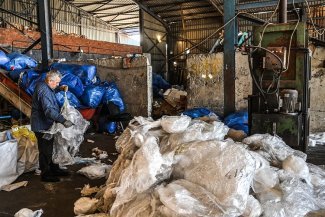Avdul is a team leader with one of the groups of minesweepers working with the HALO Trust to help clear Kosovo of the tens of thousands of unexploded ordnances scattered across the country.
"It’s like working as an archaeologist: you need lots of attention, sensitivity and discipline." The man speaking is Avdul, a 48-year-old team leader with a Chuck Norris beard. He leads four men in a field very close to the local cemetery and to a public road often used by students in Kryshec, a small village in the south-west of Kosovo. The signs on the street, with a simple word and the iconic symbol of a skull, leave no room for doubt: "Mines".
Avdul and his men are minesweepers, working for the British-American NGO HALO Trust to secure the clearance of a potential minefield.
Although it has been exactly twenty years since conflict erupted in Kosovo, the problem of unexploded cluster bombs and mines in the Kosovar countryside - which is populated by ethnic Albanians - remains widespread.
The bitter story of Kosovo’s relationship with cluster bombs and their sub-munitions begins in 1999, during the 78 days of NATO bombings in the region, and the following withdrawal of Yugoslavian forces during the Kosovo War.
In this short period of time, NATO planes released 1,392 cluster bombs, containing approximately 295,000 smaller sub-munitions. With an estimated failure rate of 20 per cent due to factors such as out-of-date explosives, soft ground impact or defective triggers, it is easy to assume that tens of thousands of unexploded ordnances (UXOs) remained buried in the gardens, fields and farms of this disputed territory.
As if that wasn’t bad enough, things took a turn for the worse in 2001, when the United Nations declared the country to be mine-free, for reasons that remain unclear, at a time when it clearly wasn’t. This resulted in a lack of funding and interest in the issue, which also impacted the activities of HALO’s work in Kosovo.
"The situation changed in 2008, after a big incident next to Pristina Airport. Two undetected cluster bombs exploded," explains Hekuran Dula, programme manager for HALO’s Kosovo office.
From its headquarters in Gjakova, a small city one and a half hours south of Pristina, he monitors the work of his 10 teams of "bomb hunters" on a huge wall map of Kosovo. The red spots, indicating the places which are still unchecked, comprise approximately half of the total marked spots on the map.
"The situation is still far from be solved, as you can see," Dula explains, "but it is getting better and better. We have found more than 40,000 bombs since 1999, clearing more than 15 square kilometres of land. Our target is to have a mine-free Kosovo for 2020, and to have it cleared of cluster bombs by 2024."
According to a 2013 survey of minefields and cluster munition strikes conducted by the Kosovo Mine Action Centre (KMAC) and consulted by Equal Times, 135 fields in the country still needed to be cleared of mines and cluster bombs.
In 2017, only 105 remained according to information provided by the HALO Trust. Although the main national mine clearance operations are conducted by the Kosovo Security Force, NGOs such as HALO Trust and Norwegian People’s Aid provide crucial additional capacity.
A deadly legacy
As one can imagine, there have been numerous civilian causalities from accidental explosions in Kosovo since the war ended in June 1999. It is estimated that more than 600 people have fallen victim to UXO detonations, buried mines or untriggered cluster bombs.
One of the last serious incidents took place in February 2017, when a child found a hand grenade and accidentally detonated it. Luckily, he escaped unhurt, but many others haven’t been so lucky. In October 2016, a woman in Pristina died after finding a hand grenade in her garden and accidently pulling the pin.
"We estimate that approximately 17 square kilometres of land has to be cleared yet - more or less 1.5 per cent of the whole Kosovar territory," says Dula. "This creates a huge problem in building infrastructure, which is a thing the country desperately needs.
"But Kosovo still lives on today, even if almost one million people left during and immediately after the war. At least half of them have come back. Those people usually go back to their villages in the mountains, close to the Albanian border, and it is there that the majority of still-undiscovered minefields potentially exist."
The problem is exacerbated by the fact that wood, mainly cut in the forests on the Kosovar-Albanian border, provides the main heating source for rural Kosovars.
It is in this territory that Equal Times finds Avdul working with his men. Getting into a mine clearance area is not easy: after an initial check, the team leader will collect the visitor and explain the safety rules to be observed inside the area. Once we’ve been kitted out in anti-explosive jackets and face protection, we are in.
"This area is very close to a cemetery," explains Avdul, passing under a big marble eagle placed on a grave. "This did not make it very easy to convince people that we needed to clear this area."
The cemetery appears to be full of graves with the two eagles of the Kosovo Liberation Army (KLA, or UÇK in Albanian) carved onto black marble tombstones. As in other graveyards in the region, many KLA soldiers, that were either killed during the war or during the bombings, are buried here. A bunch of fresh flowers lays outside the cemetery entrance as access is limited to the minesweepers until they declare it safe.
"It often happens that people reject us. Once we met a guy who didn’t want us in his terrain, saying we were friends of the Americans, and that we were looking for gold," Avdul recalls, laughing loudly at the memory.
There are precise rules to this work: any positive signal given by the metal detectors is marked with a red stick. If an actual explosive device is found, the red stick is changed to a yellow one. Then, it’s all on the minesweeper’s ability to secure and then usually detonate it.
"The main problem is the cluster bombs," explains Abaz, a 57-year-old man checking a "red stick" signal. "They are much easier find, given that they are usually completely metallic, but they are not made to be defused. We usually detonate them, but it is still very dangerous".
HALO’s manual deminers usually work eight hours per day, but this is broken into smaller 50-minute shifts, punctuated by a 10 minutes break, in order to allow the men to safely maintain focus and attention. With a monthly net salary of about €460 in a country with an official unemployment rate of between 25 and 30 per cent, these men are paid more than the average Kosovar, who receives anywhere between €300 and €400 per month.
Mine clearance work also provides rare employment opportunities for older people - some of the bomb hunters are almost in their sixties. And despite being dangerous work, Kosovo’s unexploded mines and munitions removal workers feel a deep sense of pride.
"I like to think I’m saving a life by doing this," explains Xhevet, one of Avdul’s colleagues.










